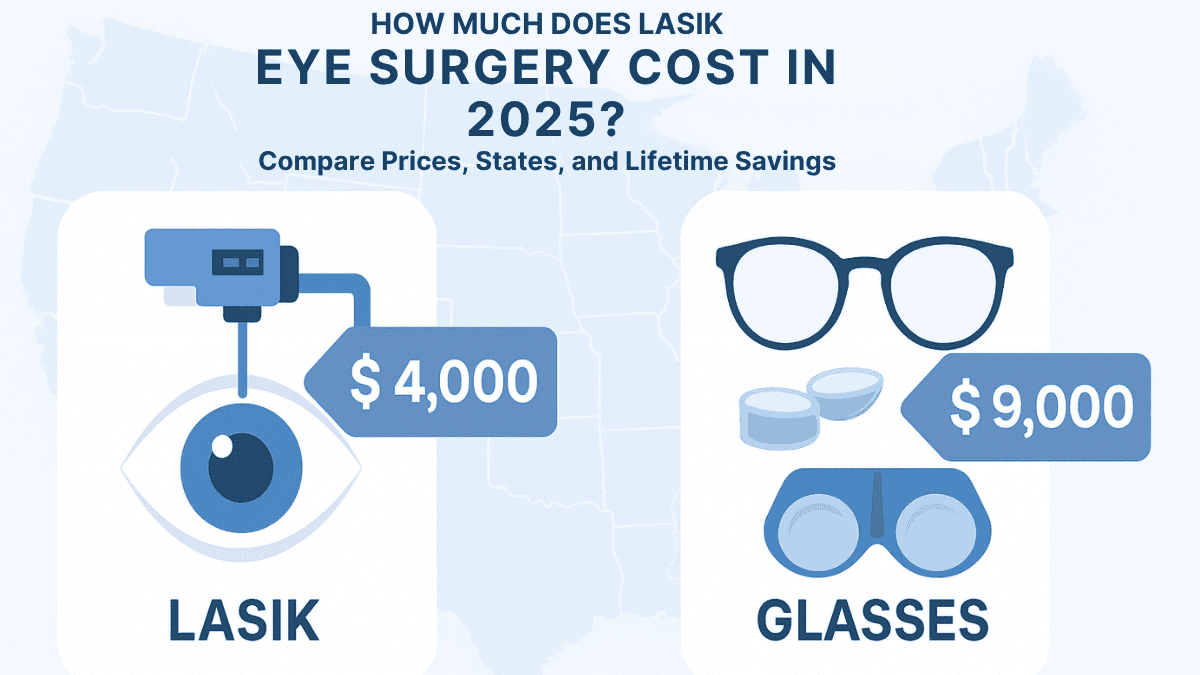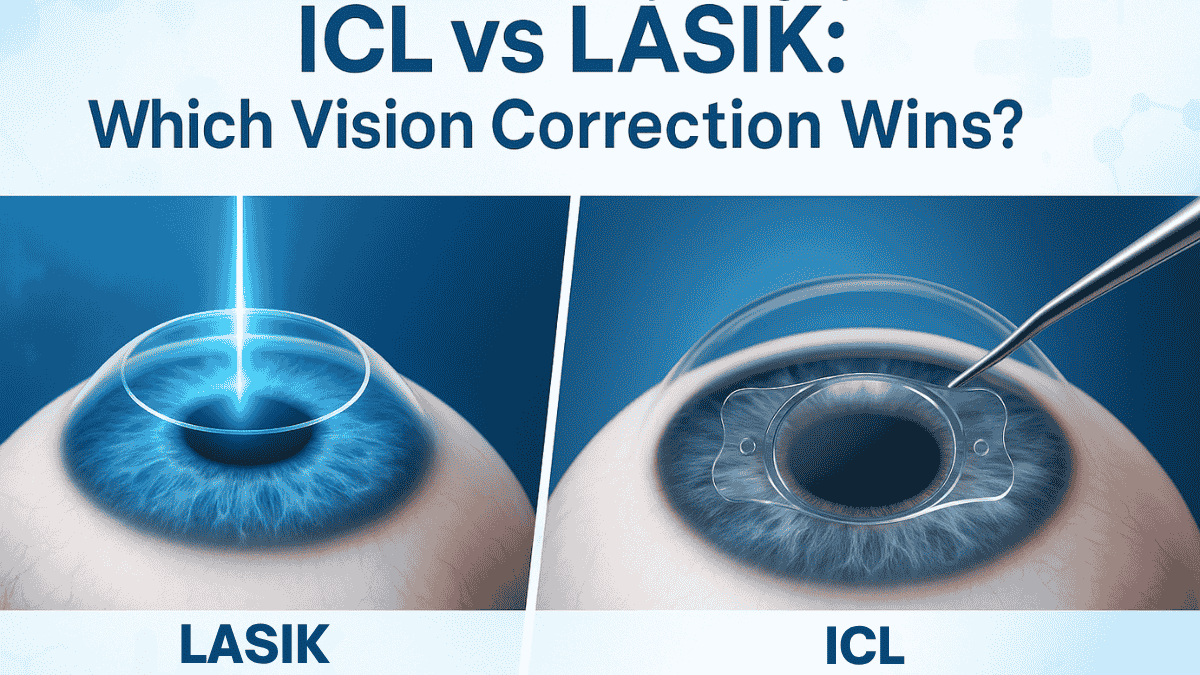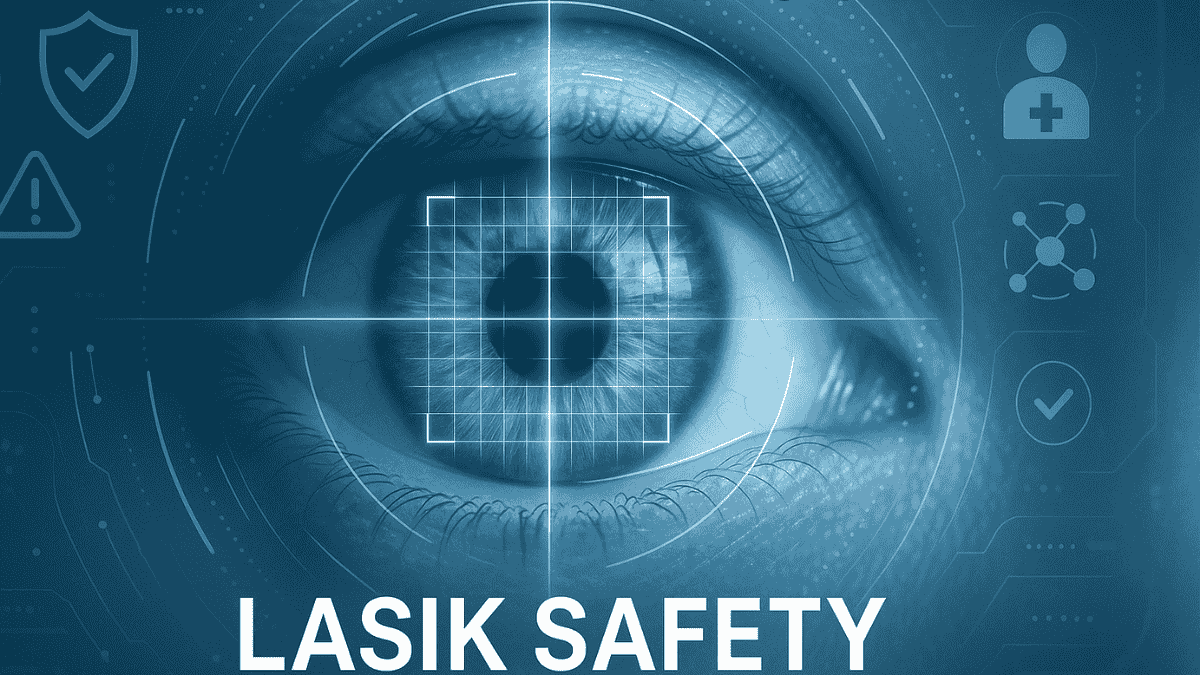
So, you’re tired of fumbling for glasses first thing in the morning, or maybe the daily ritual of contact lenses feels like a chore. Many people dream of clear vision without these aids. That’s where laser eye surgery often comes into the picture. But the big question lingers: is laser eye surgery worth it? It’s a significant decision, with both exciting possibilities and important factors to consider. Deciding if eye surgery is worth it means looking at all angles, from the daily joys to the potential drawbacks.
Table of Contents
The Upsides: What Draws People to Laser Eye Surgery?

The benefits of laser eye surgery, especially procedures like LASIK surgery, are quite appealing for many. One of the biggest draws is the sheer freedom from glasses and contact lenses. Imagine waking up and seeing the world clearly, instantly.
This liberation allows for more spontaneity in life, which is a common reason patients seek LASIK eye surgery. This newfound freedom often means less planning around eye care routines, whether it’s for an impromptu weekend trip or simply enjoying a rainy day without smudged glasses. Activities that were once cumbersome with corrective lenses become more accessible and enjoyable.
Think about swimming, playing sports, or traveling without worrying about packing solutions or breaking your frames. For many, this convenience dramatically improves their quality of life. This significant shift means embracing a life without prescription glasses, and that’s a powerful motivator.
Another major plus is the potential for improved visual clarity. Many patients report that their vision quality after LASIK eye surgery is even sharper and more vibrant than what they experienced with their best glasses or contacts. It’s often described as seeing the world in high definition for the first time.
This remarkable improvement in eyesight contributes heavily to the high satisfaction rate after laser eye surgery. Some patients even report an improved perception of colors and contrast, enhancing their overall vision quality. This enhancement can make everyday experiences, like watching a movie or appreciating nature, more vivid.
For LASIK surgery specifically, the recovery time is typically quite fast. Most people notice a significant improvement in their vision within 24 to 48 hours, sometimes even quicker after a SMILE Pro procedure. Many can return to work and most normal activities very quickly.
The use of numbing drops during the surgery procedure means minimal discomfort. This swift return to routine, often within a couple days, is a huge advantage for those with busy lives, allowing them to enjoy their improved vision almost immediately.
Then there’s the aspect of long-term surgery cost savings. While the initial investment for laser eye surgery seems high, it’s helpful to compare this to the ongoing expenses of glasses, prescription sunglasses, contact lenses, and cleaning solutions over many years. Over a decade or more, the cost vs value of LASIK surgery can lean in favor of the procedure.
For some, this financial reasoning alone makes it a compelling option for vision correction. This elective eye surgery can lead to significant savings over time.
Peeling Back the Layers: Understanding the Risks of LASIK Surgery
While the advantages are clear, it’s just as important to understand the risks of LASIK eye surgery and other laser vision correction procedures. No surgery is completely without risk. Being fully informed helps you make the best choice for your eye health and lifestyle.
One of the most common side effects is dry eyes. This happens because the LASIK eye surgery can temporarily reduce tear production. For most, this is a temporary issue that improves as your eyes heal, often managed with artificial tears.
Related Article
Managing Dry Eye Syndrome: Causes and TreatmentsBut for some, it can become a longer-term concern requiring ongoing eye treatment. Your eye surgeon will likely recommend preservative-free artificial tears and may suggest other strategies to manage symptoms effectively. It’s important to follow post-operative eye care instructions closely to help your eyes heal.
You might also hear about visual disturbances like halos, glare, or starbursts, especially around lights at night. These issues can affect night vision, making driving at night more difficult for a period. Thankfully, these symptoms often lessen or disappear as your eyes heal over several weeks or months.
Advances in laser technology, including the excimer laser used in many LASIK procedures, have also helped reduce the frequency of these side effects. While these are usually temporary, discussing them with your eye doctor during follow-up appointments is important for your eye care.
Less common, but still possible, are issues like undercorrection or overcorrection. This means your vision isn’t corrected as planned. You might not achieve perfect 20/20 vision, or you might end up slightly farsighted or nearsighted.
Sometimes, an enhancement surgery or retreatment might be needed later to fine-tune the results. This is an important part of discussing long-term results of LASIK surgery, including what happens if vision needing correction returns. The possibility of needing an enhancement procedure should be discussed with your eye surgeon, including any associated surgery costs.
Though very rare with modern technology and experienced surgeons, more serious complications can include flap issues (specific to LASIK, where a thin flap is created on the cornea) or, in extremely rare cases, vision loss. This highlights the importance of choosing a reputable eye clinic and a skilled, board-certified eye surgeon. Thorough pre-operative screening helps minimize these risks by identifying candidates who might be more prone to complications.
With modern femtosecond lasers used in many LASIK procedures, flap-related complications are much rarer. Choosing an experienced eye surgeon who performs many LASIK eye surgery procedures further minimizes such risks.
It’s also good to remember that your eyes can still change as you age, even after successful eye surgeries. For instance, many people develop presbyopia, the age-related vision change causing a need for reading glasses, typically in their 40s. Laser eye surgery corrects existing refractive errors but doesn’t prevent future age-related changes like presbyopia after LASIK eye surgery.
The post-LASIK quality of life is generally very high, but these potential issues are part of the complete picture when considering this elective eye surgery. Your eye health journey continues even after vision correction.

Beyond the Hype: Patient Satisfaction and Long-Term Results of LASIK
So, what do people really say years down the line about their surgery laser experience? When considering if laser eye surgery is worth it, looking at real-world patient outcomes is very revealing. Patient satisfaction after laser eye surgery is remarkably high.
Studies, including data from the U.S. Food and Drug Administration (FDA), consistently show a high satisfaction rate, with over 95% of LASIK surgery patients happy with their results. This high level of satisfaction speaks volumes about the impact of the procedure and how it can improve vision. This often stems from achieving realistic expectations discussed beforehand with the eye surgeon.
Factors that contribute to this satisfaction include the visual freedom achieved and the significant improvement in uncorrected vision. Many describe it as life-changing. But, satisfaction is also closely tied to realistic expectations and a good understanding of potential side effects before the surgery.
What about the long-term vision stability? The corrective effects of LASIK surgery are generally permanent. The laser reshapes the cornea, and that change doesn’t wear off.
However, as mentioned earlier, eyes can continue to change naturally over a lifetime. LASIK outcomes 5 years later, and even 10 years or more post-surgery, generally remain excellent for most people, especially those who had a comprehensive eye exam prior to the procedure.
Related Article
Blurry Vision After LASIK: Causes and What to ExpectMinor changes in prescription over many years can occur due to aging or other eye health factors, not because the LASIK eye surgery itself has failed. Sometimes, an enhancement, or a different lens surgery like lens replacement, might be considered if these changes become significant. Conditions like macular degeneration or diabetic retinopathy, if they develop later in life, are separate eye health issues that can affect vision, highlighting the need for ongoing eye care.
The post-LASIK quality of life is a huge factor for many. Imagine enjoying hobbies like swimming or hiking without the hassle of corrective eyewear. Many people report increased confidence and greater ease in their daily activities.
The ability to wake up and see clearly, or to participate in sports without worry, profoundly impacts daily living for the better, offering an improved vision quality. Of course, if persistent side effects like dry eyes occur, this can impact quality of life, which is why understanding all risks and discussing them with your eye surgeon is vital.

Is Laser Eye Surgery Worth It Financially?
The surgery cost of laser eye surgery can seem like a big hurdle. It’s natural to ask: is laser eye surgery worth it from a purely financial standpoint? Let’s break down the cost vs value of LASIK surgery.
While the upfront surgery costs can range from around $2,000 to $5,000 per eye, depending on the technology and surgeon, this investment needs to be weighed against the recurring costs of prescription glasses and contact lenses. Many factors contribute to the final surgery cost, including the specific type of laser vision correction and the eye clinic chosen.
Think about what you spend annually on eye exams, new glasses (especially if you like designer frames or need multiple pairs), prescription sunglasses, contact lenses, and all the necessary cleaning and storage solutions. Over 10, 15, or 20 years, these costs really add up. For many, LASIK surgery can actually be more economical in the long run.
Consider also the time saved from not having to clean contact lenses or visit the optician for new prescription glasses. For some, this ‘time value‘ adds to the overall worth of the elective eye surgery.
Here’s a simple comparison to illustrate the potential long-term savings:
| Expense Category | Typical Annual Cost (Glasses/Contacts) | 10-Year Cost (Glasses/Contacts) | Average One-Time LASIK Cost (Both Eyes) |
|---|---|---|---|
| Eye Exams | $100 – $200 | $1,000 – $2,000 | $4,000 – $8,000 (example) |
| Glasses (every 2 years, avg. $300) | $150 | $1,500 | |
| Contact Lenses (daily disposables) | $500 – $700 | $5,000 – $7,000 | |
| Solutions & Supplies | $100 – $150 | $1,000 – $1,500 | |
| Total Estimated 10-Year Cost (Glasses/Contacts) | $8,500 – $12,000+ |

Related Article
How Much Does LASIK Cost? A Complete Pricing GuideAs you can see from this example, the cost of maintaining vision with glasses or contacts can easily surpass the surgery costs of LASIK surgery over a decade. Your personal expenses might vary, but it’s a useful calculation to make. This helps show that life without glasses might also mean more money in your pocket over time.
Many people use Health Savings Accounts (HSAs) or Flexible Spending Accounts (FSAs) to pay for laser eye surgery with pre-tax dollars, which can make it more affordable. Clinics also often offer financing plans to spread the cost over time. Experience, technology, and thorough care from a reputable eye clinic are very important for good outcomes, so avoid choosing based on price alone.
When exploring options at an eye hospital or eye clinic, ask about these financing plans. Also, check if your insurance offers any partial coverage for specific medically necessary lens surgery, though most laser vision correction is considered elective eye surgery.
Not a Perfect Fit for Everyone: When to Reconsider

Laser eye surgery, including advanced options like SMILE Pro, offers incredible benefits, but it’s not a universal solution. Certain factors can make someone unsuitable for the elective eye surgery. A comprehensive eye exam and consultation with an experienced ophthalmologist are critical to determine if you are a good candidate.
Honesty during this consultation at the eye hospital or eye clinic about your health and expectations is very important. Before any surgery procedure, you will review consent forms detailing the surgery, risks, and benefits; make sure you read them thoroughly, even if some formatting appears as generic terms like ‘label label’ or ‘checkbox label’ on digital versions.
One key factor is a stable eye prescription. If your vision is still changing significantly year to year, which is common in late teens or early twenties, or due to certain conditions, it’s usually best to wait. Operating on an unstable prescription means the results might not last as long, and your vision needing correction may return sooner.
Specific eye conditions can also be disqualifiers. For example, individuals with very thin corneas might not be suitable for LASIK surgery, though they might be candidates for other vision correction options like photorefractive keratectomy (PRK). Severe dry eye disease can be worsened by LASIK eye surgery, so it needs to be well-managed before surgery, or an alternative eye treatment might be better.
Related Article
Can You Get LASIK with Thin Corneas? Risks and AlternativesConditions like keratoconus (a progressive thinning and bulging of the cornea), macular degeneration, or active diabetic retinopathy generally rule out standard laser vision correction. Other conditions like advanced glaucoma might also influence candidacy for certain types of eye surgery, though some glaucoma treatment options might be compatible. A thorough screening is essential.
Your overall eye health matters too. Uncontrolled autoimmune diseases, such as Sjogren’s syndrome or rheumatoid arthritis, can affect how your eyes heal. Diabetes that is not well managed can also increase risks associated with any surgery laser procedure.
It’s crucial to discuss your complete medical history with your eye surgeon. Many eye clinics provide a patient portal where you can share this information securely before your appointment, facilitating better eye care.
Finally, having realistic expectations is vital. While the goal is significantly improved vision and freedom from corrective lenses, perfection (such as guaranteed 20/20 vision without any side effects) cannot be promised. Understanding the potential for needing reading glasses later in life due to age-related vision changes like presbyopia, or the slight chance of needing an enhancement, helps set a realistic outlook for your patient’s vision. Being able to read small print without glasses after surgery is a common goal, but presbyopia will eventually affect near vision for most people.
Exploring Other Paths to Clearer Vision
If LASIK surgery isn’t the right fit for you, don’t worry. There are other excellent vision correction options available. Your eye doctor can discuss these alternatives based on your specific eye health and visual needs.
These correction options can still lead to a greatly improved quality of life and potentially a life without prescription glasses for distance vision. Many eye clinics offer a way to book free consultations to explore these eye surgeries and refractive surgery choices.
One common alternative is photorefractive keratectomy (PRK). PRK was actually the first type of laser eye surgery and is still widely performed. It’s often recommended by your eye surgeon for people with thinner corneas or those in professions with a higher risk of eye trauma.
Related Article
Safe Alternatives to LASIK: PRK, LASEK, and Ortho-K ExplainedThe main difference from LASIK surgery is that the surgery procedure does not create a corneal flap. Instead, the excimer laser works directly on the surface after the outermost layer of the cornea (epithelium) is gently removed. The visual outcome is similar to LASIK eye surgery, but the recovery period is typically longer and involves a bit more discomfort initially as the eyes heal, often taking a couple days for initial improvement and longer for full stabilization.
However, the long-term results of PRK are comparable to LASIK procedures, offering excellent improved vision. The surface ablation in PRK allows the epithelium to heal naturally, covered by a protective bandage contact lens, making it a strong contender among correction options for suitable candidates.
Another option, particularly if offered by your chosen eye clinic, is SMILE Pro (Small Incision Lenticule Extraction). This procedure is minimally invasive compared to LASIK because it doesn’t involve creating a corneal flap. Instead, the laser creates a small, lens-shaped piece of tissue (lenticule) within the cornea, which is then removed through a tiny incision.
SMILE surgery pros and cons include potentially fewer issues with dry eyes and faster corneal nerve regeneration compared to LASIK eye surgery. The minimally invasive nature of SMILE Pro might lead to quicker recovery of corneal strength, though it currently treats a more limited range of refractive errors than LASIK surgery or PRK.
Beyond laser-based refractive surgery, there are other advanced options. For instance, Implantable Collamer Lenses (ICLs) are an alternative for those with high degrees of nearsightedness or thin corneas where laser eye surgery might not be suitable. These are like permanent contact lenses inserted inside the eye, working with the natural lens to correct vision problems. Many patients achieve excellent vision quality with ICLs, and they are a good choice for patients not ideal for LASIK procedures due to high prescriptions or dry eye.
Related Article
ICL Surgery for High Prescription Eyes: What to ExpectAnother significant vision correction option is lens replacement surgery, sometimes referred to as refractive lens exchange (RLE) or clear lens exchange. This procedure is similar to cataract surgery, where the eye’s natural lens is removed and replaced with an artificial intraocular lens (IOL). RLE can correct a wide range of vision problems, including high nearsightedness, farsightedness, and presbyopia, potentially eliminating the need for reading glasses even for seeing small print.
Some advanced IOLs, like the light adjustable lens, allow for post-operative adjustments by your eye surgeon to fine-tune vision, offering a highly customized outcome. This lens replacement or lens exchange can be a good alternative to vision laser surgery for certain age groups or prescriptions.
Cataract surgery itself is a common lens surgery that removes the clouded natural lens and replaces it with an IOL, significantly improving vision. While often associated with age-related vision issues, it’s a highly successful procedure. For individuals with cataracts who also have refractive errors, premium IOLs used during cataract surgery can correct both conditions simultaneously, often performed in an eye hospital or specialized eye clinic.
Less common but important for post-cataract surgery patients is the YAG laser capsulotomy. Sometimes after cataract surgery, the membrane behind the implanted lens can become cloudy, causing blurry vision. A YAG laser is used in a quick, painless outpatient laser capsulotomy procedure to create an opening in this capsule, restoring clear vision. This is different from primary vision correction but is a crucial eye treatment for maintaining clarity after lens surgery.
And, of course, continuing to use glasses or contact lenses is always a valid choice. Modern eyewear is incredibly advanced, comfortable, and stylish. The decision ultimately rests on what feels best for your vision, lifestyle, and comfort level with surgical procedures.
Conclusion: So, Is Laser Eye Surgery Worth It for You?
Deciding if laser eye surgery is worth it is a deeply personal journey. It involves carefully weighing the incredible benefits of clear vision and freedom from corrective lenses against the potential risks and surgery costs. Think about your lifestyle, your visual needs, your tolerance for potential side effects, and your financial situation.
The high satisfaction rate after laser eye surgery and the excellent long-term results of LASIK surgery suggest that for many, the answer is a resounding yes. The goal to improve vision is often successfully met, leading to a better quality of life.
The potential for an improved post-LASIK quality of life, free from the daily hassles of glasses or contact lens products, is a powerful motivator. But it’s a medical procedure, and understanding all aspects, including that not everyone is a perfect candidate and results can vary, is important. For many individuals, the surgery cost vs value of LASIK surgery becomes clear when they consider the long-term savings and daily convenience.
Ultimately, figuring out if laser eye surgery is worth it for your specific situation comes down to thorough research and a detailed discussion with a trusted eye care professional at a reputable eye clinic or eye hospital. Your individual eye health will play a large role in this decision.
To truly understand if this path is right for you, the best step is to book a free consultation if available, or schedule one with a qualified and experienced, board-certified eye surgeon. They can perform a comprehensive eye exam, discuss your specific vision correction options, and help you make an informed decision based on your individual eyes and needs. This professional guidance from an eye hospital or clinic is invaluable when considering such an important step for your eye care and improved vision.
For many patients, laser eye surgery is worth it due to long-term savings, improved vision quality, and freedom from corrective eyewear.
LASIK typically provides permanent vision correction, although natural aging can still affect eyesight over time.
Over 95% of LASIK patients report satisfaction with their vision and the results of their procedure.
The procedure is virtually painless. Patients may feel slight pressure during the surgery and mild discomfort in the hours following.
Most patients return to work within 24 to 48 hours after LASIK, depending on their healing process and visual demands at work.
While many patients no longer need glasses, some may still require them for certain tasks, especially as they age.
Yes, modern LASIK technology can correct most forms of astigmatism, improving overall clarity of vision.
Many patients notice improved vision within a few hours, with stabilization over several days.
Like any medical procedure, LASIK carries risks, including dry eyes, glare, halos, or under/overcorrection.
Not everyone is a candidate. Factors like thin corneas, unstable prescriptions, and certain health conditions may disqualify patients.
The cost varies by location and provider, but it generally ranges from $2,000 to $3,000 per eye in the U.S.
While LASIK results are long-lasting, some patients may need enhancements or develop presbyopia with age.
Most insurance plans consider LASIK elective and do not cover the procedure, but financing options are usually available.
You need a comprehensive eye exam to assess factors like corneal thickness, eye health, and prescription stability.
If the desired correction isn’t achieved, enhancement surgery or alternative treatments may be recommended.






